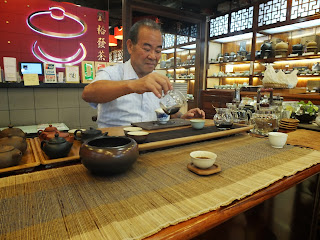My recent tea ware purchase was this Japanese tea caddy. This tea ware is made in Kyoto and such ceramic works are known as Kyo ware. This tea caddy measures about 2.8 inches high with its girth at about 2.8 inches as well. This tea caddy comes with a cow bone lid with gold foil lining the base of the lid. A cloth bag call shifuku was included in this purchase.
I was informed that the lid of the tea caddy was made from cow bone. Such lids may also be made from resin, bone and even ivory. I found the lid extremely light. It looks very nice aesthetically but I would prefer the lid to be designed like a stopper so that this caddy can be carried about easily without worrying about losing the lid.
The overall appearance of this tea caddy is very attractive. The high reflective surface easily makes this tea caddy a great conversation piece while you are having a tea session with guests. Did you notice the reflection of a camera tripod on the tea caddy?
But I digress…..I had put some oolong in this tea caddy and took this tea caddy to visit my friend for a tea session. He had the impression that the oolong was expensive since I had used such elaborate tea ware. He remarked, when we had brewed the tea, that the oolong was an old and high grade oolong. We had a good laugh when I told him the tea was a Sea dyke oolong. Lesson learnt - never judge a tea by its tea caddy……or buy an expensive tea caddy; your tea will taste much better.















